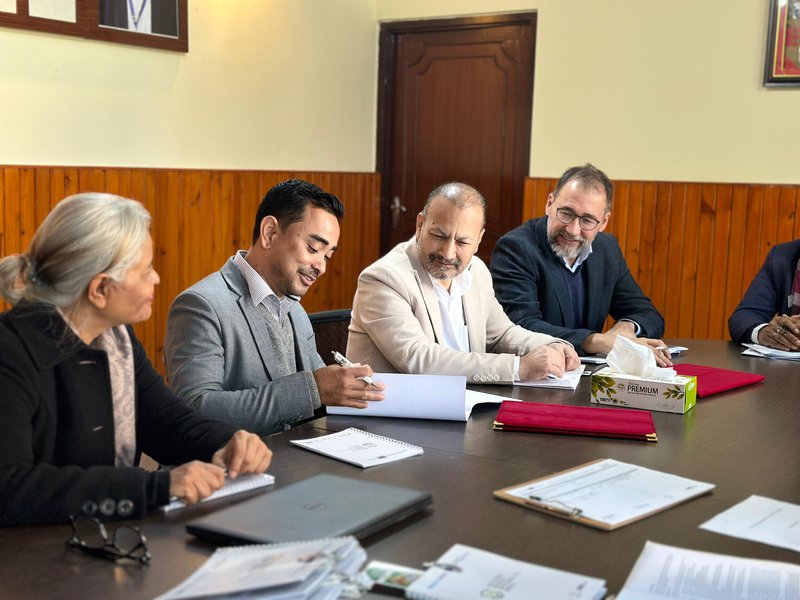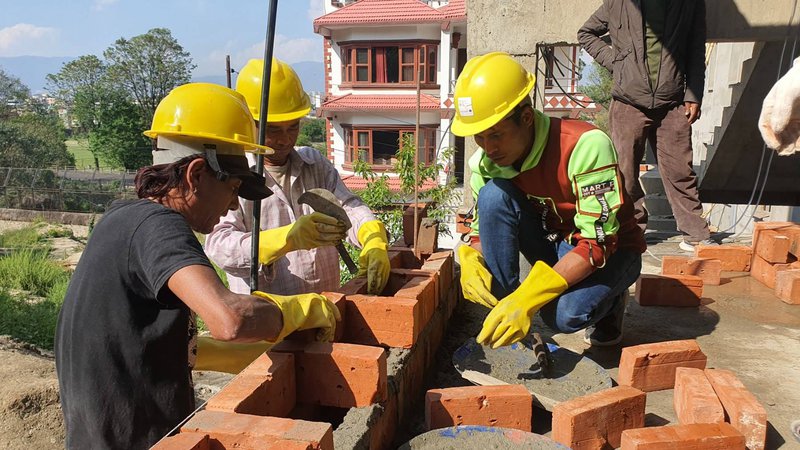

Studies indicate that buildings account for more than one-third of Nepal's total energy consumption, a figure that is on the rise due to increasing incomes, extreme temperatures, and urbanization. As Nepal's building footprint expands, the country has the opportunity to prioritize energy efficiency and reduce emissions.
Current buildings in Nepal exhibit high operational energy usage, with heating and cooling accounting for 60 percent of energy consumption in modern structures. The building stock in Nepal also has a significant environmental impact.
Recent data from the Nepal Electricity Authority reveals a rapid increase in electricity consumption in households across all regions. To manage electricity supply to households, NEA has implemented four-hour load shedding during peak times.
"Despite improvements in electricity supply, we are forced to implement power cuts to industries during the peak four hours," stated Chandan Kumar Ghosh, NEA spokesperson. Winter electricity demand has surged by nearly 20 percent compared to last year, with peak demand reaching approximately 1800 MW."
The second National Determined Contribution (NDC) highlights sectors with increased energy demand and stresses the importance of adaptation and mitigation. It suggests using low-emission technologies in industries like brick and cement to reduce coal consumption and air pollution.
Dr. Maheshwor Dhakal, head of the Climate Change Management Division, noted that the building sector is a significant carbon emitter. The second NDC report focuses on ensuring new buildings comply with energy efficiency measures. The Climate Change Management Division is enhancing coordination among stakeholders through meetings. The Ministry of Urban Development is creating mandatory energy-efficient guidelines for new public construction.
The NDC also promotes designing energy-efficient buildings, but implementation is challenging. Nepal aims for zero emissions by 2045 and has already submitted its NDC. T
he Ministry of Urban Development and the Department of Urban Development and Building Construction are holding consultations on energy-efficient buildings at the federal level to achieve the zero emissions target by 2045.
Binu Bajracharya Kunwar, spokesperson for the Ministry of Urban Development, stated that the Ministry is currently developing policy guidelines for public buildings, as the approval of private building designs is under the jurisdiction of local governments.
The BUILDING Energy Efficiency in Nepal (BEEN) project, funded by the European Union under the SWITCH-Asia Program and led by the University of Innsbruck, Austria (UIBK), in collaboration with MinErgy Pvt Ltd, Nepal, Greentech Knowledge Solution Pvt Ltd, India, and Asociacion Espanola de Normalizacion (UNE) Spain, has been operating in 60 municipalities across Bagmati, Gandaki, and Lumbini Provinces for the past three years. The project provides technical support to develop energy-efficient building guidelines.
Among the 60 municipalities, 21 have already implemented energy-efficient building codes for new constructions, including Pokhara Metropolitan City and Lalitpur Metropolitan City.
BEEN's approach is appropriate as the Constitution of Nepal authorizes local governments to approve private building constructions. The organization has signed MoUs with numerous municipalities, and any major decision by the federal government can lead to significant changes. In December 2024, BEEN signed an MoU with the Department of Urban Development and Building Construction (DUDBC).
The MoU was signed by Prakrina Tuladhar, Deputy Director General of DUDBC, and BEEN’s team leader Suyesh Prajapati in the presence of Jose Luis Vinuesa-Santamaria, Head of Cooperation, Delegation of the European Union to Nepal.
The European Union Nepal highlighted the significance of this milestone on its Facebook page, emphasizing the promotion of energy-efficient buildings in the country. Jose Luis Vinuesa-Santamaria's presence and discussions during the signing ceremony between the BEEN project and DUDBC inspired the project team.
The European Union is committed to supporting the DUDBC in implementing energy-efficient green building initiatives and developing policy guidelines.
The partnership has been welcomed by Er Machakaji Maharjan, Director-General of DUDBC, who expressed gratitude for the collaboration. He expects the partnership to lead to significant progress in DUDBC's history. The goal of the partnership is to create a policy environment that promotes energy-efficient building design and construction at the national level.
Energy-efficient buildings are crucial for sustainability efforts, as outlined in the second NDC. Green buildings not only reduce energy costs but also have a lower carbon footprint. By utilizing renewable energy sources, they decrease reliance on coal-powered plants and help reduce greenhouse gas emissions.
Suyesh Prajapati, Team Leader of BEEN, stated, "Our objective is to promote low-carbon and resource-efficient construction in Nepal's construction sector by facilitating the development, construction, and renovation of environmentally friendly buildings." The MoU signed with DUDBC will play a significant role in expediting this process.
Prajapati highlighted the success of BEEN in promoting energy efficiency at both local and national levels. Out of 60 local governments, 50 have started the process of adopting energy efficiency agendas through by-laws.
BEEN has conducted training sessions for over 200 technical staff from these municipalities to enhance their capacity.
As a result, 125 energy-efficient buildings have been constructed with BEEN's support in these areas. Additionally, more than 250 Micro, Small, and Medium Enterprises (MSMEs) from various sectors have received training to offer energy-efficient services and products.
The demand for floor space and energy-consuming services like lighting, air conditioning, and computers is increasing rapidly. A study predicts that Nepal's floor space will quadruple by 2050, mirroring global trends in building stock growth.
Achieving the zero-emission goal by 2045 is impossible without drastically reducing energy consumption in buildings. Therefore, the second NDC prioritizes urban adaptation and mitigation. In this context, BEEN's strategy is becoming more relevant, as highlighted by the recent MoU signed between the DUDBC and BEEN.
Dr. Dhakal, head of the Climate Change Management Division, emphasized that the sectors related to urban mitigation include energy consumption in house construction, transport, and mobility. The second NDC also focuses on promoting climate-responsive building designs and retrofitting.
The Challenge:
Nepal's population is predominantly rural, but the country is experiencing rapid urbanization. It is projected that 1 million homes will be built in Nepal over the next decade. Additionally, significant growth is expected in the tourism and hospitality sector, as well as in commercial buildings.
In recent years, the demand for space in the market has led to buildings being designed without taking into account the local climate. This has resulted in high energy consumption for heating and cooling, contributing to the overall increase in operational energy requirements in Nepal's urban areas. Additionally, the use of building materials with high embodied energy has further increased the carbon footprint of the building sector in Nepal.
It is crucial to reduce energy consumption in buildings, but Nepal currently lacks standards, guidelines, or regulations for energy-efficient building design in new construction or retrofitting existing buildings.
Awareness and capacity among building sector MSMEs regarding energy-efficient buildings and services are also low. While structural stability in buildings has been a focus in Nepal due to earthquakes, there is a lack of consideration for climate responsiveness and energy efficiency in most new building designs.
BEEN's Support
BEEN has been actively promoting climate-responsive building designs, retrofitting, and the adoption of energy-efficient space heating and cooling technologies, as well as resource-efficient building materials and renewable energy sources.
The organization has collaborated with various stakeholders to develop passive design guidelines, design tools, technical standards, and manuals for municipalities. Additionally, they have conducted training programs in partnership with local governments and related associations.
In line with the European Green Deal and the EU Circular Economy Action Plan, BEEN is advocating for circular economy strategies in the building sector.
By supporting green technologies through capacity building, policy interventions, and financial support, BEEN is facilitating the transition to a low-carbon, resource-efficient, and circular building sector.
BEEN's efforts align with national commitments to climate change mitigation, recognizing the significant role of the building sector in achieving sustainability goals.

Implementing building energy codes, appliance standards, and retrofitting policies can help cities and countries ensure long-term energy efficiency in buildings.
As Nepal aims to mandate net-zero energy buildings in their codes by 2045 or earlier, policy-level interventions in building construction are crucial for achieving this goal.
Nepal is among the 53 countries that emphasize building energy efficiency in their Nationally Determined Contributions (NDCs). The country specifically highlights building energy codes, underscoring the significance of energy efficiency in the climate future.
Nepal's NDCs outline various strategies to maximize building energy efficiency potential, such as implementing energy codes for new and existing buildings, setting appliance standards, establishing energy efficiency resource standards, introducing rating systems, setting renovation targets, and defining energy consumption goals.
Following the Paris Agreement negotiations, Nepal has shown a renewed commitment to building energy efficiency policies. Effective coordination is crucial for the successful implementation of NDCs. While the Ministry of Forest and Environment is responsible for developing the NDC and related plans, other ministries and local governments play a significant role in overseeing construction and policy implementation.
Achieving climate goals related to building energy use is more feasible when local governments receive support from national governments in terms of financial resources and tools.
- Global IME Capital’s “Samunnat Yojana 2” Mutual Fund Opens for Public Offering from July 6
- Jul 03, 2025
- Nepal Among Investment-Friendly Countries, Immense Opportunities Exist – Prime Minister
- Jul 03, 2025
- Supreme Court upholds appointment of 52 officials
- Jul 03, 2025
- Weather Forecast: Generally Cloudy In The Hilly Areas With Heavy Rainfall In Some Areas Of Bagmati And Koshi Province
- Jul 03, 2025
- MCA-Nepal Welcomes Continued U.S. Support for MCC Nepal Compact Implementation
- Jul 02, 2025















